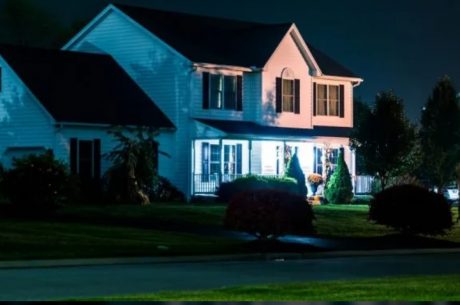Flooding is one of the most destructive natural disasters, and its impact on homes, businesses, and communities can be devastating. With extreme weather events becoming more frequent, it’s critical for homeowners to take proactive steps to prevent water damage. One highly effective approach is landscaping—when done right, it can safeguard your property and help you avoid costly water damage restoration.
1. Why Landscaping is Key in Preventing Water Damage
Landscaping isn’t just about aesthetics—it plays a crucial role in flood mitigation and water damage prevention. A well-designed landscape can redirect water, enhance drainage, and reduce the risk of soil erosion and foundation damage.

The sloping of your landscaping helps prevent rainwater from flooding your lawn.
A fundamental aspect of flood remediation landscaping is grading. Proper grading ensures water flows away from your home, not toward it. Ideally, your yard should slope at least six inches for every ten feet away from your foundation. This reduces the chances of basement flooding and the need for emergency water extraction.
Additionally, replacing impermeable surfaces with permeable pavers, gravel, or grass pavers encourages water absorption, minimizing runoff and potential flood damage.
2. Rain Gardens: A Natural Solution to Water Overflow
One of the most eco-friendly methods to manage stormwater and prevent flooding is through a rain garden. This shallow, planted depression captures runoff from roofs, driveways, and patios, allowing it to slowly infiltrate the soil.
To be effective:
- Position it at least 10 feet from your home.
- Use native plants with deep root systems that support water absorption and reduce erosion.

A rain garden collects runoff water to minimize flooding and maximize water quality.
Rain gardens are not just beautiful; they help reduce the need for flood cleanup and improve your yard’s overall health and resilience.
According to the U.S. Department of Agriculture, native plants don’t require fertilizers and use less water, which helps prevent erosion.
3. Swales: Directing Water Away from Your Home
Swales are shallow, sloped channels that guide excess water away from your home and toward safe drainage zones. They are especially helpful in preventing home water damage restoration situations after heavy rains.
Enhance your swale with:
- Grasses or ground cover to slow water flow.
- Gravel or rocks at the base for better filtration.
Combined with rain gardens or French drains, swales form a robust system that minimizes the risk of flooded basements and water extraction emergencies.
4. The Power of Trees and Shrubs in Flood Mitigation
Strategically planted trees and shrubs are natural water managers. Their root systems absorb excess moisture, reduce runoff, and prevent erosion. When placed thoughtfully, they can also intercept rainfall before it reaches the ground.
For effective flood remediation landscaping, consider native species like:
- River birch
- Willow
- Oak
These species thrive in wet conditions and support long-term water damage recovery.
5. French Drains: Subsurface Solutions for Water Redirection
A French drain is a simple yet powerful tool for redirecting water away from water-prone areas. It involves a perforated pipe in a gravel-filled trench, channeling water toward a designated drainage area.
Steps for installation:
- Dig a trench along water collection zones.
- Ensure the trench slopes downward.
- Cover with gravel and topsoil or grass.

A French drain helps steer your excess water to a different location in your landscaping.
French drains are especially helpful in areas with heavy clay soil, where water tends to pool. They also reduce reliance on emergency flood response services.
6. Retaining Walls: Controlling Water on Sloped Landscapes
On properties with elevation changes, retaining walls are essential. These structures hold back soil and help redirect water flow, reducing the likelihood of erosion and flooding.
Use materials like:
- Concrete blocks
- Brick
- Natural stone
Don’t forget drainage! Installing weep holes or drainage layers behind the wall prevents pressure buildup and reduces the risk of water mitigation efforts later on.
7. Maintain Your Landscape to Stay Flood-Ready
Preventative landscaping requires ongoing care. Without regular maintenance, even the best systems can fail—leading to water cleanup needs and possible sewage cleanup if systems back up.
Key maintenance tasks:
- Clear debris from swales, rain gardens, and sump pump extraction areas.
- Prune trees and shrubs for optimal water absorption.
- Check and regrade your yard to ensure water flows properly.
Staying proactive helps reduce the risk of roof leaks, water heater leaks, and hidden issues that may require leak detection services.
When Landscaping Isn’t Enough, Call PuroClean for Help
Despite your best efforts, nature can still take its toll. If you’re facing a flooded basement, roof leak, or need emergency water extraction, PuroClean is here for you.
Our certified technicians specialize in:
- Water damage restoration
- Water drying and water mitigation
- Water damage clean-up
We’re your local water remediation company, committed to helping you recover quickly and safely. Whether it’s flood help, water damage remediation in Pompano Beach and South Florida, or immediate flood restoration, we’re just a call away, 954-546-9090, calling PuroClean can be a game-changer.
Don’t wait until it’s too late—invest in flood-preventing landscaping and keep PuroClean on speed dial for any water emergencies.



